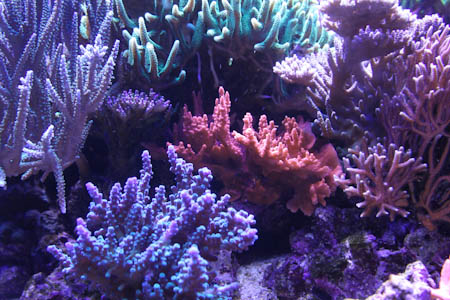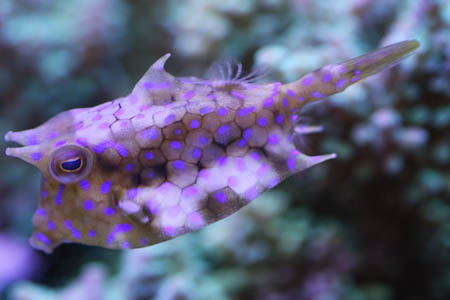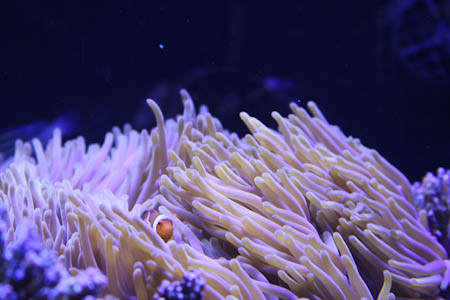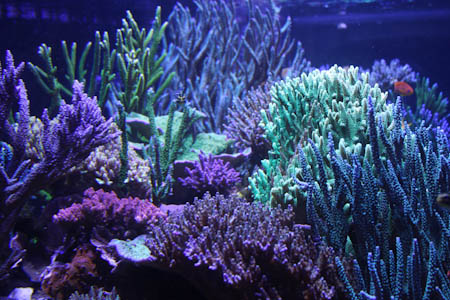 Tanks of the Month
Tanks of the Month
Tanks of the Month
Tylor Armstrong's (tylorarm) Reef Aquarium
 |
Introduction
First, I would like to thank my wife Kimberly for her patience and understanding. Second, to my children, Kailey and Sage, for lending a helping hand and adding a couple watchful eyes. When I decided to upgrade from a 125 gallon aquarium to the 480 gallon tank, I asked my wife for permission. She said “no way in hell”. From that point on I decided to go with the old Reef Central adage approach. I figure it’s better to ask for forgiveness than permission. This was especially pertinent as I only asked my wife for permission once but had designed the system and ordered all the equipment, including a custom built 84”x48”x28” four side low iron Elos braceless aquarium and a Bubbleking 400ext. You could use the poker analogy, I was pot committed.
I’ve always been fascinated by nature and the sea, and this hobby serves my interest well. It is constantly evolving, and continually challenging. I’ve had several large failures and many small traumas, but the reward of overcoming these difficulties has been worth the price. My favorite part of this hobby is the process more so than the product, but both are gratifying. When I worked many hours a week and had a growing family, my limited free time seemed to preclude such a time consuming hobby. But to me reef keeping was my therapy, a relaxing and rewarding distraction from other stresses.
 |
Background
The current system is a replacement for a 125 gallon tank that ran into problems when the top brace cracked. The crack was probably the result of a combination of 400w metal halide lighting adding heat while a Tunze wavemaker added stress. Once the crack appeared I decided to take advantage of the misfortune and find a bigger home for my overcrowded SPS coral and growing fish. I decided on a custom braceless, four sided low iron glass aquarium with considerable depth and length that would look good behind my couch in our living room. I worked with Jesse at Elos to design a custom tank that would fit the space, and Elos did the rest. The tank featured two dry overflows and two closed loop boxes built on its bottom so I could have two live rock islands with well integrated outflows built into the rock structure. The flow was designed as two circles around and through the rock islands. I continued to run the 125 gallon tank once its 480 gallon replacement was up so I could slowly transfer occupants once the new system cycled. Unfortunately, as my lengthy project dragged on and the coral continued to grow and overcrowd my 125 gallon. The 125g began to decline and I lost many corals before the 480g was ready. I also lost some of the rationale for the much larger tank in the process, but, undeterred, I decided to give away what remained of my SPS and start fresh, all with frags from other hobbyists.
The transfer of fish, LPS coral and zoanthids from the 125gl to the 480gl went smoothly. I also built a fish room for filtration equipment in our basement. The fish in particular were very happy with the new and larger home, at least until I made my next large mistake. I had an opportunity to buy a Clarion Angel. The first legally imported into the USA in many years. Instead of just one, I bought four. My thought was I’d keep the smallest and donate the other three to the Academy of Science’s aquarium. The problem arose when I only had two quarantine tanks in my basement. The Clarions looked very healthy but nearly immediately began to dismantle each other. In particular, the little one I had bought for my tank was clearly going to be killed. So, I decided to take a chance and moved the small Clarion into my display after only one week of quarantine. Soon most of my fish would die from a combination of ich and velvet, and I would learn another lesson the hard way. From that point all fish in my 480g display will have been through a three week QT that features two weeks of Cupramine treatment and 10 days of Prazipro treatment. There will be no exceptions.
 |
The Move
About two years ago I moved the 480g tank and all its occupants when our family moved from Piedmont to Marin, a 40 minute drive apart. The tank went from the middle of our Piedmont living room, where it was an island and four sides viewable, to against the wall in our living room in Marin. I only lost one occupant during the move, my good old green spotted mandarin, and had no coral losses. I had received a lot of help from Erin of Octopuses Garden. It was a big job that needed to be done in a short time frame, no way I could have done it without Erin’s help.
 |
System Profile
• Display tank: Custom 480g Elos braceless (84”x48”x28”). The tank has four sides low iron glass (19mm), and a 31 piece bottom (38mm). It weighs around 1,300lbs dry, and considerably more with water. There are three separate closed loops. The inflows are in the side overflow chambers and the outflows are drilled into two bottom glass boxes, custom designed for what began as an island tank, with four sides viewable. Now it is more like an in wall display, but it functions well none the less.
• Sump: 280g (60”x30”x24”) custom built by Gen at Kritters.
• Skimmer: Bubbleking 400ext.
• Lighting: 3 Lumenmax reflectors with 400w Aquaconnect 14k bulbs, 4 Reefbright LED strips (blue) and 2 140w VHO actinic bulbs. All the lights are on an aluminum structure that can be raised and lowered with a remote control.
• Circulation: A Reeflo Hammerhead return, four Tunze 6350’s and two Tunze 6250’s, three closed loops with two Red Dragon 12M3 and one RD10M3 pumps. I also have Tunze powerheads in the system’s 160g cistern and the 125g RDSB.
• RO/DI: I use two 160g plastic cisterns. One is plumbed into the system. The other holds RODI. This greatly helps for water changes. I cut the cisterns water input from the sump off by turning a ball valve, then drain the water. I Pump in water from a second cistern that contains RODI water, then add a bucket of salt and mix. Then I just turn the ball valve back on (usually let mix for 24hrs) and it’s back on the system. Thus, I can change 160g of water with about 15 minutes of labor.
• Calciuym Reactor: GEO 6" x 18".
• Controller: Neptune Systems Apex Controller, three Ranco temperature controllers.
Maintenance and Redundancy
Through much of the system’s history I’ve held a very demanding job and worked many hours a week. Now that I’m retired, I travel more often. Thus, I’ve tried to keep maintenance demands down through automation and prevent disasters through remote monitoring and redundancy. My RODI is completely automated through a series of optical switches, float switches and an electronic solenoid. I can also do a 160 gallon water change with about 15 minutes of labor! I control temperature with 3 Ranco controllers, each heater is double controlled with the heaters internal thermostat set at 78 degrees. Heating and water flow are on several different electric circuits, all of which are GFCI. I also have a backup generator that connects through a transfer switch, powering the aquarium, refrigerators and a few of the house’s lights and outlets. I use the Apex primarily for controlling lights, C02 and some pumps, and monitoring temperature and water levels. The Apex sends me text messages to my iPhone if problems arise such as temperature, sump PH, calcium reactor PH, sump water levels, or water on the floor. When I get such text alarms I usually go check the system but I can also turn off lights, pumps or C02 from my phone if needed. I’ve also set up my lighting so that I can raise it up to 36” by remote control. Last but not least, I get help from time to time from Marcos at Planet Reef, who has been invaluable when I travel and when I have tasks that need two people. Marcos also helped me set up my 125g tank when I moved it from LA to Piedmont, and provided much insight over the years as well.
 |
Always Changing
The current system has evolved over time. When I moved the tank from Piedmont I made large changes, and many smaller changes since. The biggest factor was the necessity to change from a tank that was four sides viewable to an against wall layout. Once against the wall, much of the argument for an open top was lost, and my family grew tired of the bright lights and noise emanating from the display. Therefore, I decided to have a stand built around it to make it look much more like an in-wall aquarium. Acanthus cabinets did a beautiful job doing so, and what I lost in access I more than made up with less noise, humidity, extraneous light and now have a new clean look that matched the house. I also have adjusted lighting, filtration and flow over time. Once enclosed the lighting look didn’t matter, and I swapped out a Giesemman Spectra fixture with a platform made from aluminum tube that I am able to move up and down remotely. I still use three Acquaconnect 400w bulbs, but now housed in Lumenmax reflectors. I added four Reefbright LEDs and two 140w VHO actinic bulbs, replacing four T5 bulbs. I definitely like the actinic supplement of the VHOs better than the T5s, but I probably lost a little PAR. Once I began using a phosphate reactor my refugium never really grew macro algae well. Therefore, I switched to four remote deep sand beds in my garage fish room, including using the 125g that was a refugium. A few months back I added a pellet reactor as a carbon source, but I haven’t noticed much impact from this addition on the system. One thing is certain, as long as I have the system I’ll be making adjustments trying to keep up with its growing occupants.
 |
|
Water Parameters:
|
Fish
Most of the fish now in my aquarium I bought after yet another catastrophe related to an exterminator (corals were unaffected) a couple years back. I decided early on to have a smaller number of pampered fish rather than a larger starved population in order to keep nutrients in the water low, and SPS corals happy. Also, some of the fish I have are challenging, especially the Copperband, which will only eat fresh clams or live blackworms. Currently I have:
|
Fish:
|
 |
 |
Corals and H. Magnifia
It is a good thing I had convictions regarding using only frags from other peoples systems. The one inch frags in a very large aquarium looked very sparse for quite some time. I mostly bought frags from people on Reef Centra,l plus a couple from Atlantis’ display tank. I also bought a couple from Steve Tyree during a Bay Area Reefer’s event. I have quite a variety of corals, but most are either Acropora or Montipora species. All were treated with Tropic Marin’s Pro Coral Cure prior to introduction. My oldest coral is an LPS, a pink Goniopora, that came from the 125g. When I designed my set up I also was determined to get a H. Magnifica anemone. My plan was to place it at the top of my biggest island then surround it with coral, and have the SPS and anemone live together. Things went very well at first, as the coral’s upward growth outpaced the anemone’s lateral growth. However, as the H. Magnifica went from around six inches in diameter to 20 inches, it began to kill off the exposed branches of the SPS corals that pen it in its spot. However, I still view this as an acceptable loss as I love the movement the H. Magnifica provides and it is fun to watch the True Percula Clowns pop out every now and again.
 |
 |
 |
 |
Acknowledgements
Before I embarked on this journey I read many of the available reef books to form a base of knowledge. I also learned from the local community, including Marcos (Planet Reef) and Erin (Octopus Garden). However, the majority of information necessary for success over time has come from Reef Central and its many participants. Some of my system design is original and my own, and I’ve tried to share what I’ve come up with on RC, returning a small amount of the favor. But the majority of ideas that formed my rather complicated system have come from RC participants. For instance, I designed my lighting system from the posting of a very similar one created by another reefer (GlassReef) posted on RC. In fact, there are too many examples to mention here, ranging from plumbing manifolds to water chemistry (thanks Boomer and Randy). Also, the vast majority of coral has come from other RC participants, especially Tim (TFP). The sharing of information and even corals is what makes this hobby progress, and it’s come a long way over the past decade.
 |
Feel free to comment or ask questions about my tank in the Tank of the Month thread on Reef Central.



